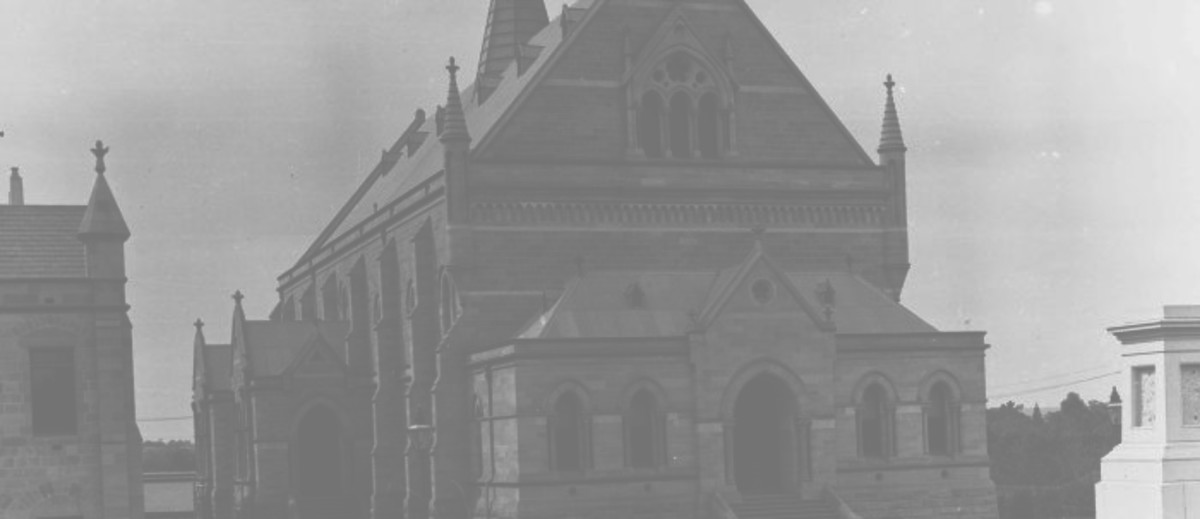Place
ContributeThe simplicity of the stone exterior of Elder Hall gives little indication of the richness of its interior hammer beam ceiling and the resonance of its Casavant Freres organ. Named after Sir Thomas Elder, the building was the first constructed at the University of Adelaide as a result of his philanthropy. A wealthy businessman and pastoralist, Elder left £65 000 to the university upon his death in 1897, of which £20 000 was devoted to music. Elder loved music, as Governor Sir Thomas Buxton noted at a public meeting on 28 March 1898: ‘Sir Thomas gave large sums to provide the best training in music. He gained pleasure and relief from music, and he desired so to encourage music in our midst that it should be still further disseminated, and that education in this subject should be brought home to the masses’ (Advertiser, 29 March 1898).
By 1897 Elder had already donated substantial amounts to the university for musical education. He contributed funding for a Chair of Music and established an annual scholarship for South Australian students to attend the Royal College of Music in London.
Establishing a concert hall
The University Council decided that half of his final bequest would be used to establish a Conservatorium of Music and the other half to erect a building to house it. This would enable the training of world-class musicians and provide an important venue for public concerts. At the time the only other major venue for music performance in Adelaide was the Town Hall.
The Council determined that the building would be arranged so as to add to the cultural precinct developing along the northern side of North Terrace east. Elder Hall was sited between and set back from the facades of the Exhibition and Mitchell Buildings, and designed to be in harmony with them. The location of the hall was also intended to encourage clearing up the area, which was littered with the remnants of early colonial structures.
Elder Hall was designed in a Florentine Gothic style by architect Frank John Naish (1844–1904) and constructed by North Adelaide-born master builder Walter Charles Torode (1858–1937). Freestone for most of the building came from Torode’s quarry at Stirling West. The dressings, quoins and turrets were made of Mount Gambier freestone. The Hall’s interior featured an open hammer beam roof with 13 large principals and polished timber ceiling. The concert hall was designed to seat 1000 people, with an orchestra and chorus area accommodating up to 300 people. The stage allowed for up to 150 performers. The building also included dressing rooms, teaching rooms on the ground level and in the basement, rooms for the professor and staff, and a smaller performance hall. A pipe organ built by JE Dodd of Twin Street, Adelaide was added to the main hall soon after the building’s completion.
The foundation stone for Elder Hall was laid by Governor Buxton with great ceremony on 26 September 1898. The handle of the silver trowel used in the laying of the stone ‘was made from a portion of the historic gumtree at Glenelg’ (South Australian Register, 27 September 1898; 29 September 1898).
Elder Hall was unofficially opened with a concert on 27 April 1900 before ‘a representative and fashionable audience’ of more than 1000. The official opening on 26 September 1900 was attended by the new governor, Lord Tennyson. Elder Hall quickly became an important venue for meetings, concerts, recitals and student balls. It was used for all university exams and degree ceremonies until Bonython Hall was completed in 1936.
The Elder Conservatorium of Music
The university’s Elder Professor of Music, Joshua Ives, was the first director of the Elder Conservatorium of Music. In 1898, through the Conservatorium, the university was the first in Australia to provide for a Doctor of Music. In 1902 Edward Harold Davies was awarded the first Australian Doctorate of Music and in 1918 Ruby Davy was the first woman in Australia to be awarded a Doctorate of Music.
The Conservatorium has hosted outstanding students. Several distinguished composers and performing musicians have been members of staff. One of these made a particular contribution to the Conservatorium and the cultural life of Adelaide. John Bishop, son of a saddler from Aldinga, studied at the Conservatorium before taking up a scholarship at the Royal College of Music, London. In 1948 he was appointed Elder Professor of Music and director of the Elder Conservatorium. With Sir Lloyd Dumas, managing editor of the Advertiser newspaper, Bishop initiated the Adelaide Festival of Arts. He was appointed artistic director of the first festival, held in March 1960.
In the modern era
Elder Hall has undergone alteration over the years and was completely refurbished in 1978 and 2006. The Dodd organ was enlarged in 1934, but by the mid 1970s was in need of restoration. With the upgrading of Elder Hall in 1978 the university decided to acquire a new organ. In 1979 a spectacular organ built by Casavant Freres of Quebec was installed. Crafted in the French Classical tradition, the organ is regarded as one of the finest instruments in the country. The Dodd organ was bought by St Mark’s Catholic Cathedral in Port Pirie.
Elder Hall continues to be an important venue for public events. From 1999 Elder Hall has been a focal point for Adelaide’s Festival of Ideas. Music festivals and public concerts by Australian and overseas artists are held there, and an annual lunchtime series of concerts by Conservatorium staff and students has been popular.
Media
Add mediaImages

Courtesy City of Adelaide Archives. HP0084. Not to be reproduced without permission.

Courtesy of the University of Adelaide Archives. UAA: 780.72 A228c Series 2.

Courtesy the University of Adelaide Archives. UAA S695.

Courtesy of the University of Adelaide Archives. UAA S695.






CommentAdd new comment
Quickly, it's still quiet here; be the first to have your say!